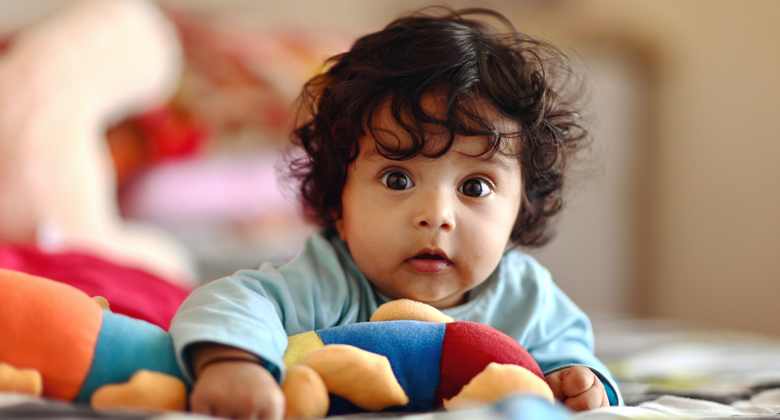You already know your little one is absolutely brilliant and full of wonder. Learning activities can be a great way to feed their curiosity and are meaningful bonding activities for caregiver and baby. You'll also be delighted to see even more ways that your baby is already intuitive and their reactions to new perspectives you offer them.

Image by Rajesh Rajput
Helping your child develop
While baby learning activities can be fun and entertaining for you and your baby, they are also very important to help your child along in key areas of child development. These exercises can help them socially, emotionally, and even help strengthen their movement skills. There are key areas any activity with baby should aim to improve:
Gross motor skills
Strengthening your baby’s muscles, especially their neck and back, are crucial to helping them be able to move their head and sit up on their own. Any body movement that takes multiple muscle groups like turning their head is a gross motor skill.
Fine motor skills
When your baby reaches for your hair or shirt and grasps it, they are using fine motor skills. These actions your little one does require targeted control of muscles and often takes a lot of practice for them to develop the skills. Fine motor skills are crucial for later development around 6 months or later when your baby can begin to grasp small objects to eat finger foods for self-feeding.
Building a stronger bond with baby
Your infant will naturally build a bond with you as you care for them. Bonding is essential for your baby’s well being and can also help relieve caregiver stress as physical skin-to-skin contact releases oxytocin (the hormone of attachment that gives a warm and fuzzy feeling).
Going beyond the regular caregiving responsibilities to interact with your baby in more intentional ways will help strengthen your bond and help your baby develop at the same time. Below you’ll find some ways to integrate learning activities into your daily routines.

Image by Shirota Yuri
10 baby learning activities
- Carry your baby in a sling or carrier as you go about your daily activity. The changing scenery will be visually interesting to them and the higher vantage point will help your baby see the world around them.
- Let your baby have hang-out time on a blanket with a baby gym overhead. Your baby will find the contrasting colors (such as black and white or primary colors) of the dangling toys entertaining and visually stimulating.
- Coo, sing, and talk to your baby. This is how they learn! Watch how your baby will look at your eyes and lips while you communicate with them. Hint: Babies love high-pitched sounds (even if your dog doesn’t).
- Play peek-a-boo. This teaches your baby cause and effect and eventually they will learn that you don’t disappear even when you are under that blanket (this is called object permanence).
- Massage or lightly tickle your baby (especially those little piggy toes!) This will stimulate your baby’s sense of touch.
- Sit with your baby in front of a mirror and encourage them to look at themselves and you. Make silly faces and see if your baby tries to mimic you.
- Play music for your baby in the car and at home, as studies have shown that this is beneficial to their developing brains!
- Read to your baby and show them the pictures. Even though your baby is too young to follow along, your voice, along with the colorful pictures, will still create a multi-sensory learning experience.
- Play “What do I hear?” Anytime you hear a sound, like a dog barking or the washing machine whirring, ask your baby, “what is that sound? And then answer, “that’s a doggie!” or, “that’s the washing machine.” Hearing labels for common things will help them develop language skills in the months to come.
- Play finger and toe games with your baby, such as This Little Piggy or The Itsy Bitsy Spider. These games will engage your baby’s sense of touch while they also listen to the sound of your voice.
Baby learning toys
Many toys have been invented that can help facilitate baby learning activities. Many of these toys have been around for decades. You may recognize fisher-price’s classic Rack-a-Stack toy that helps babies learn hand eye coordination and motor skills as they move around to stack each piece.
There are also newer baby learning toys that you can attach to their carseat or crib to help them stay engaged while you rest or handle chores. The best toys keep your baby engaged and develop their mind by stimulating multiple senses and giving them a sense of accomplishment. Be sure to check the safety labels of each toy you give your baby to ensure it’s age-appropriate.

Give a post-activity meal and rest
Learning new things takes a lot of your baby’s focus and energy. It’s likely you yourself are also tired from caregiving and playing with the baby. Give yourself a pat on the back continuing to do a wonderful job (and take a nap when you can)!
Be sure to replenish your baby’s body with fruits and veggies and protein to help them grow in both body and mind. Sprout’s foods are organic & non-GMO with no concentrates or preservatives. You can find your baby’s new favorite foods today and have them shipped directly to your home.

